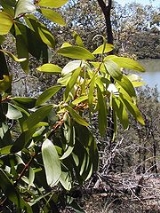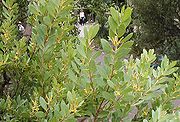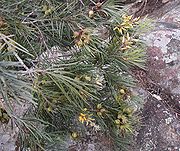
Persoonia
Encyclopedia
Persoonia is a genus
of 98 species of shrub
s and small tree
s in the tribe Persoonioideae
in the large and diverse plant family Proteaceae
. In the eastern states of Australia
, they are commonly known as Geebungs, while in Western Australia
and South Australia
they go by the common name Snottygobbles. The generic name is in honour of Dutch
mycologist
and botanist
Christiaan Hendrik Persoon.
All species are endemic
to Australia
, though a closely related species, Toronia toru is found in New Zealand and has been described as a species within the genus Persoonia previously. They are widespread in non-arid regions. One species, P. pertinax, is found only in the Great Victoria Desert
, while a few other species venture into the arid zone, but most are concentrated in the subtropical to temperate parts of south eastern and south western Australia, including Tasmania.
term was jibbong.
Interactions between micro-organisms and Persoonia species are poorly known, and no mycorrhizal associations have been reported for any species of Persoonioideae
. Several species of Persoonia (P. elliptica
, P. gunnii
, P. longifolia
, P. micranthera
, P. muelleri
) are known to be highly susceptible to infection by an Oomycete, Phytophthora cinnamomi
, in the wild and this pathogen is strongly suspected of being responsible for the deaths of many other species in cultivation.
The sclerophyll
ous plant communities where Persoonia species usually live are fire-prone environments, hence Persoonia species have adapted to frequent bushfires. The most obvious adaptations are features that allow plants to survive fires, albeit in a more-or-less pruned state. Many species, especially in the south west, are lignotuberous, resprouting
from ground level after fire. Several also develop thick bark that protects epicormic buds, which resprout from trunks and large branches after fire. The most eye-catching of these are the four “paper-barked” species: P. falcata
, P. levis
, P. linearis
and P. longifolia
. Branch resprouters with less conspicuous protective bark include P. amaliae, P. elliptica
, P. katerae
and P. stradbrokensis
. Fire-sensitive species survive fires as buried seeds, which tend to germinate prolifically after disturbance. These species seem to require an interval of at least eight years between fires, allowing newly germinated plants to reach reproductive maturity and establish a replacement seed bank. The natural patterns and processes involved in this kind of life cycle, including seed longevity, the environmental cues that stimulate germination, and even the time from germination to first flowering are still poorly understood.
The best studied interaction between animals and Persoonia species is that between the plants and their pollinators. All species that have been studied in detail have been found to be pollinated by a variety of native bees, but especially species of Leioproctus
subgenus Cladocerapis (Colletidae
), which rarely visit any plants but Persoonia (see Maynard 1995, Bernhardt and Weston 1996). The behaviour of these bees on Persoonia flowers is quite predictable. Both males and females alight on the cross-shaped “platform” formed by the recurved anther tips, orient themselves to be facing one of the anther/tepals, then slide, face first, down between the anther and the style to reach the two glands at either side of the base of the tepal, and drink the nectar from them. Females gather pollen grains with their legs while drinking nectar. The insect then withdraws to the top of the flower, makes a 180º turn, then repeats the process on the other side of the flower. Another species group in Leioproctus
, subgenus Filiglossa, also specialises in feeding on Persoonia flowers but these smaller bees seem to be nectar and pollen “thieves”, not effective pollinators. The introduced honeybee, (Apis mellifera) is also a frequent visitor of Persoonia flowers at most sites but it is still unclear whether this species is an effective pollinator.
The fleshy fruits of Persoonia species are clearly adapted for animal dispersal but it is still unclear whether mammals such as possums and wallabies, or large flying birds such as currawong
s are the most important dispersers. Parrots, also feed on Persoonia fruits, but the fruit (and seed) they eat are unripe, and hence their interaction with the plants is predatory rather than symbiotic.


Genus
In biology, a genus is a low-level taxonomic rank used in the biological classification of living and fossil organisms, which is an example of definition by genus and differentia...
of 98 species of shrub
Shrub
A shrub or bush is distinguished from a tree by its multiple stems and shorter height, usually under 5–6 m tall. A large number of plants may become either shrubs or trees, depending on the growing conditions they experience...
s and small tree
Tree
A tree is a perennial woody plant. It is most often defined as a woody plant that has many secondary branches supported clear of the ground on a single main stem or trunk with clear apical dominance. A minimum height specification at maturity is cited by some authors, varying from 3 m to...
s in the tribe Persoonioideae
Persoonioideae
The Persoonioideae are a subfamily of closely releted genera within the large and diverse Proteaceae family and incorporates such genera as Persoonia, Acidonia, Toronia and Placospermum....
in the large and diverse plant family Proteaceae
Proteaceae
Proteaceae is a family of flowering plants distributed in the Southern Hemisphere. The family comprises about 80 genera with about 1600 species. Together with the Platanaceae and Nelumbonaceae they make up the order Proteales. Well known genera include Protea, Banksia, Embothrium, Grevillea,...
. In the eastern states of Australia
Eastern states of Australia
In Australia, the term eastern states refers to the states adjoining the east coast of Australia. These are the mainland states of New South Wales, Queensland and Victoria. The Australian Capital Territory and Jervis Bay Territory, while not states, are also included. The term usually includes the...
, they are commonly known as Geebungs, while in Western Australia
Western Australia
Western Australia is a state of Australia, occupying the entire western third of the Australian continent. It is bounded by the Indian Ocean to the north and west, the Great Australian Bight and Indian Ocean to the south, the Northern Territory to the north-east and South Australia to the south-east...
and South Australia
South Australia
South Australia is a state of Australia in the southern central part of the country. It covers some of the most arid parts of the continent; with a total land area of , it is the fourth largest of Australia's six states and two territories.South Australia shares borders with all of the mainland...
they go by the common name Snottygobbles. The generic name is in honour of Dutch
Netherlands
The Netherlands is a constituent country of the Kingdom of the Netherlands, located mainly in North-West Europe and with several islands in the Caribbean. Mainland Netherlands borders the North Sea to the north and west, Belgium to the south, and Germany to the east, and shares maritime borders...
mycologist
Mycology
Mycology is the branch of biology concerned with the study of fungi, including their genetic and biochemical properties, their taxonomy and their use to humans as a source for tinder, medicinals , food and entheogens, as well as their dangers, such as poisoning or...
and botanist
Botany
Botany, plant science, or plant biology is a branch of biology that involves the scientific study of plant life. Traditionally, botany also included the study of fungi, algae and viruses...
Christiaan Hendrik Persoon.
All species are endemic
Endemic (ecology)
Endemism is the ecological state of being unique to a defined geographic location, such as an island, nation or other defined zone, or habitat type; organisms that are indigenous to a place are not endemic to it if they are also found elsewhere. For example, all species of lemur are endemic to the...
to Australia
Australia
Australia , officially the Commonwealth of Australia, is a country in the Southern Hemisphere comprising the mainland of the Australian continent, the island of Tasmania, and numerous smaller islands in the Indian and Pacific Oceans. It is the world's sixth-largest country by total area...
, though a closely related species, Toronia toru is found in New Zealand and has been described as a species within the genus Persoonia previously. They are widespread in non-arid regions. One species, P. pertinax, is found only in the Great Victoria Desert
Great Victoria Desert
The Great Victoria Desert is a barren and sparsely populated desert area of southern Australia.-Location and description:The Great Victoria is the biggest desert in Australia and consists of many small sandhills, grassland plains, areas with a closely packed surface of pebbles and salt lakes...
, while a few other species venture into the arid zone, but most are concentrated in the subtropical to temperate parts of south eastern and south western Australia, including Tasmania.
Taxonomy
The term geebung is derived from the Dharug language word geebung, while the WiradjuriWiradjuri language
Wiradjuri is a Pama–Nyungan language of the Wiradhuric subgroup. It was the traditional language of the Wiradjuri people of Australia, but is no longer in general use. The process of reclaiming the language was greatly assisted by the publication in 2005 of A First Wiradjuri Dictionary by elder...
term was jibbong.
Ecology
Most species are plants of well-drained, acid, siliceous soils that are low in nutrients, although one, Persoonia graminea, grows in swampy habitats, three others (P. acicularis, P. bowgada and P. hexagona) tolerate mildly calcareous soils, and several south eastern species sometimes grow on basalt-derived soils, and but these are exceptional. The greatest diversity of species is found in areas with soils derived from sandstones and granites.Interactions between micro-organisms and Persoonia species are poorly known, and no mycorrhizal associations have been reported for any species of Persoonioideae
Persoonioideae
The Persoonioideae are a subfamily of closely releted genera within the large and diverse Proteaceae family and incorporates such genera as Persoonia, Acidonia, Toronia and Placospermum....
. Several species of Persoonia (P. elliptica
Persoonia elliptica
Persoonia elliptica, commonly known as snottygobble, is a shrub native to Western Australia....
, P. gunnii
Persoonia gunnii
Persoonia gunnii is a shrub native to Tasmania....
, P. longifolia
Persoonia longifolia
The Upright Snottygobble , also known as the Long-leaf Persoonia or just Snottygobble, is a species of tall shrub or small tree in the plant genus Persoonia, reaching 1 to 5 metres in height. It is found in the Jarrah forests of southwest Western Australia...
, P. micranthera
Persoonia micranthera
Persoonia micranthera, commonly known as the small-flowered snottygobble, is an endangered prostrate shrub with yellow flowers and thin bark. It grows only on two peaks, Bluff Knoll and Isongerup Peak, in the eastern section of the Stirling Range, Western Australia...
, P. muelleri
Persoonia muelleri
Persoonia muelleri is a shrub native to Tasmania....
) are known to be highly susceptible to infection by an Oomycete, Phytophthora cinnamomi
Phytophthora cinnamomi
Phytophthora cinnamomi is a soil-borne water mould that produces an infection which causes a condition in plants called root rot or dieback. The plant pathogen is one of the world's most invasive species and is present in over 70 countries from around the world.- Life cycle and effects on plants :P...
, in the wild and this pathogen is strongly suspected of being responsible for the deaths of many other species in cultivation.
The sclerophyll
Sclerophyll
Sclerophyll is the term for a type of vegetation that has hard leaves and short internodes . The word comes from the Greek sclero and phyllon ....
ous plant communities where Persoonia species usually live are fire-prone environments, hence Persoonia species have adapted to frequent bushfires. The most obvious adaptations are features that allow plants to survive fires, albeit in a more-or-less pruned state. Many species, especially in the south west, are lignotuberous, resprouting
Resprouter
Resprouters are plant species that are able to survive fire by the activation of dormant vegetative buds to produce regrowth.Plants may resprout by means of lignotubers at the base or epicormic buds on the trunk or major branches....
from ground level after fire. Several also develop thick bark that protects epicormic buds, which resprout from trunks and large branches after fire. The most eye-catching of these are the four “paper-barked” species: P. falcata
Persoonia falcata
Persoonia falcata, commonly known as the wild pear, is a shrub native to northern Australia....
, P. levis
Persoonia levis
Persoonia levis, commonly known as the broad-leaved geebung, is a shrub native to New South Wales and Victoria in eastern Australia. It reaches 5 m in height and has dark grey papery bark and bright green asymmetrical sickle-shaped leaves up to 14 cm long and 8 cm wide...
, P. linearis
Persoonia linearis
Persoonia linearis, commonly known as the narrow-leaved geebung, is a shrub native to New South Wales in eastern Australia.-Taxonomy:...
and P. longifolia
Persoonia longifolia
The Upright Snottygobble , also known as the Long-leaf Persoonia or just Snottygobble, is a species of tall shrub or small tree in the plant genus Persoonia, reaching 1 to 5 metres in height. It is found in the Jarrah forests of southwest Western Australia...
. Branch resprouters with less conspicuous protective bark include P. amaliae, P. elliptica
Persoonia elliptica
Persoonia elliptica, commonly known as snottygobble, is a shrub native to Western Australia....
, P. katerae
Persoonia katerae
Persoonia katerae is a shrub native to New South Wales in eastern Australia....
and P. stradbrokensis
Persoonia stradbrokensis
Persoonia stradbrokensis is a shrub native to New South Wales and Queensland in eastern Australia....
. Fire-sensitive species survive fires as buried seeds, which tend to germinate prolifically after disturbance. These species seem to require an interval of at least eight years between fires, allowing newly germinated plants to reach reproductive maturity and establish a replacement seed bank. The natural patterns and processes involved in this kind of life cycle, including seed longevity, the environmental cues that stimulate germination, and even the time from germination to first flowering are still poorly understood.
The best studied interaction between animals and Persoonia species is that between the plants and their pollinators. All species that have been studied in detail have been found to be pollinated by a variety of native bees, but especially species of Leioproctus
Leioproctus
Leioproctus is a genus in the plaster bee family Colletidae. Its members are primarily found in Australasia and temperate South America, and include the most common native bees in New Zealand...
subgenus Cladocerapis (Colletidae
Colletidae
Colletidae is a family of bees, and are often referred to collectively as plasterer bees or polyester bees, due to the method of smoothing the walls of their nest cells with secretions applied with their mouthparts; these secretions dry into a cellophane-like lining...
), which rarely visit any plants but Persoonia (see Maynard 1995, Bernhardt and Weston 1996). The behaviour of these bees on Persoonia flowers is quite predictable. Both males and females alight on the cross-shaped “platform” formed by the recurved anther tips, orient themselves to be facing one of the anther/tepals, then slide, face first, down between the anther and the style to reach the two glands at either side of the base of the tepal, and drink the nectar from them. Females gather pollen grains with their legs while drinking nectar. The insect then withdraws to the top of the flower, makes a 180º turn, then repeats the process on the other side of the flower. Another species group in Leioproctus
Leioproctus
Leioproctus is a genus in the plaster bee family Colletidae. Its members are primarily found in Australasia and temperate South America, and include the most common native bees in New Zealand...
, subgenus Filiglossa, also specialises in feeding on Persoonia flowers but these smaller bees seem to be nectar and pollen “thieves”, not effective pollinators. The introduced honeybee, (Apis mellifera) is also a frequent visitor of Persoonia flowers at most sites but it is still unclear whether this species is an effective pollinator.
The fleshy fruits of Persoonia species are clearly adapted for animal dispersal but it is still unclear whether mammals such as possums and wallabies, or large flying birds such as currawong
Currawong
Currawongs are three species of medium-sized passerine birds belonging to the genus Strepera in the family Artamidae native to Australasia. These are the Grey Currawong , Pied Currawong , and Black Currawong . The common name comes from the call of the familiar Pied Currawong of eastern Australia...
s are the most important dispersers. Parrots, also feed on Persoonia fruits, but the fruit (and seed) they eat are unripe, and hence their interaction with the plants is predatory rather than symbiotic.
Species


|
|

